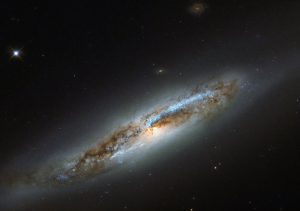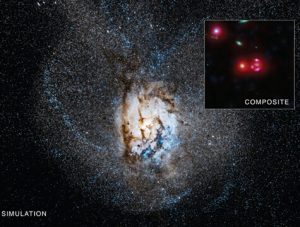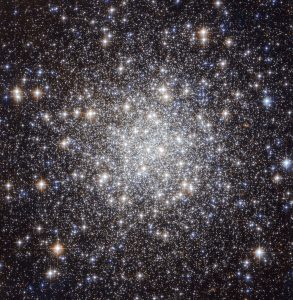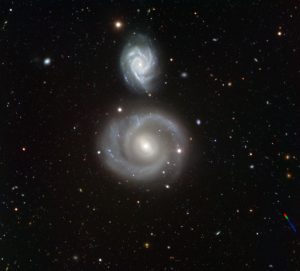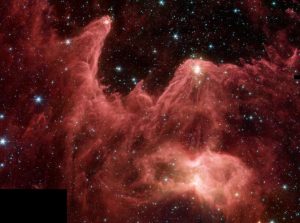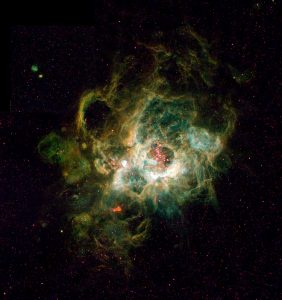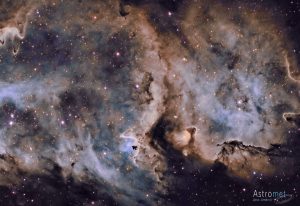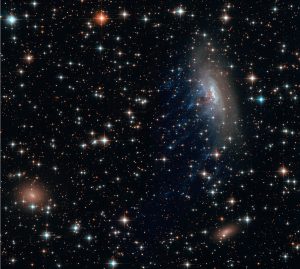formazione stellare
Gioielli del Cielo Australe
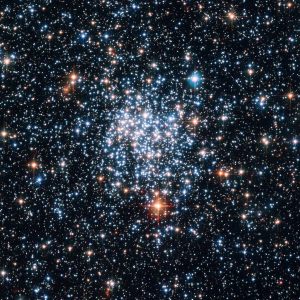 In questa straordinaria immagine ripresa dal telescopio Hubble l’ammasso stellare aperto NGC 265 s’illumina del bagliore di una miriade di stelle, simili a pietre preziose. Continua a leggere
In questa straordinaria immagine ripresa dal telescopio Hubble l’ammasso stellare aperto NGC 265 s’illumina del bagliore di una miriade di stelle, simili a pietre preziose. Continua a leggere
Metamorfosi nella Vergine
Questa volta l’obiettivo del telescopio Hubble è una galassia molto particolare, NGC 4388, soggetta suo malgrado ad una trasformazione radicale che ne ha alterato l’intera struttura, quasi si trattasse di una vera e propria metamorfosi. Continua a leggere
Tripudio di stelle in una lontana galassia
Una galassia distante, scoperta recentemente, si illumina del bagliore di una quantità straordinaria di stelle neonate, formandole ad un ritmo forsennato. La prolifica galassia, chiamata SPT 0346-52, si trova a 12,7 miliardi di anni luce dalla Terra ed è stata quindi osservata circa un miliardo di anni dopo il Big Bang. Continua a leggere
Nuova luce sulle prime stelle dell’Universo
Un team di astronomi dell’Università di Notre Dame ha individuato quella che potrebbe essere la seconda generazione di stelle, rivelando nuovi indizi sulla natura dei primi astri nati nell’Universo. Continua a leggere
La Calma Prima della Tempesta
Grazie alla vista frontale con cui si presentano al nostro sguardo, possiamo ammirare la struttura dei caratteristici lunghi bracci che si dispiegano attorno al brillante nucleo centrale di queste due splendide galassie, NGC 799 e NGC 800. Continua a leggere
Montagne della Creazione
In questa maestosa immagine ripresa dal telescopio Spitzer possiamo ammirare pilastri simili a montagne dove nascono stelle. Soprannominate “Montagne della Creazione”, queste colonne di gas freddo e polveri sono illuminate sulla sommità dalla luce di calde stelle neonate. Continua a leggere
Un fuoco d’artificio di nascita stellare
Questa festosa nebulosa colorata è una delle più vaste regioni di formazione stellare in una galassia vicina. NGC 604 è simile alle regioni di nascita stellare nella nostra galassia, come la familiare Nebulosa di Orione, ma è di gran lunga più estesa, quasi 1.500 anni luce, e contiene molti più astri di recente formazione. Continua a leggere
Ragnatela di galassie
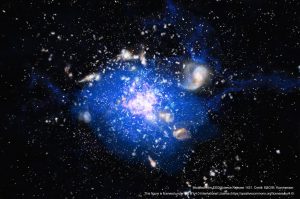 Gli astronomi studiando un ammasso di protogalassie ancora in formazione distante più di 10 miliardi di anni luce hanno scoperto che una galassia gigantesca nel centro dell’ammasso si sta formando da un’enorme nube di gas molecolare sorprendentemente densa. Continua a leggere
Gli astronomi studiando un ammasso di protogalassie ancora in formazione distante più di 10 miliardi di anni luce hanno scoperto che una galassia gigantesca nel centro dell’ammasso si sta formando da un’enorme nube di gas molecolare sorprendentemente densa. Continua a leggere
W5: L’Anima della Formazione Stellare
Molte volte le stelle si formano in regioni energetiche, in cui gas e polveri vengono spinte e compresse in un caotico scompiglio. Vicino al centro di W5, la Nebulosa Anima (Soul Nebula) ripresa in questa splendida immagine, sono presenti stelle che esplodono, e astri emettono luce ionizzante insieme a energetici venti stellari. Continua a leggere
Galassia in fuga
La galassia a spirale ESO 137-001 si presenta come un dente di leone catturato dalla brezza in questa ripresa del telescopio Hubble.
La galassia è diretta in alto a destra nell’immagine, tra altre galassie dell’Ammasso del Regolo, ad oltre 200 milioni di anni luce di distanza. La strada è difficile: il gas intergalattico nell’ammasso è diffuso, ma così caldo che brilla nei raggi X. Continua a leggere
